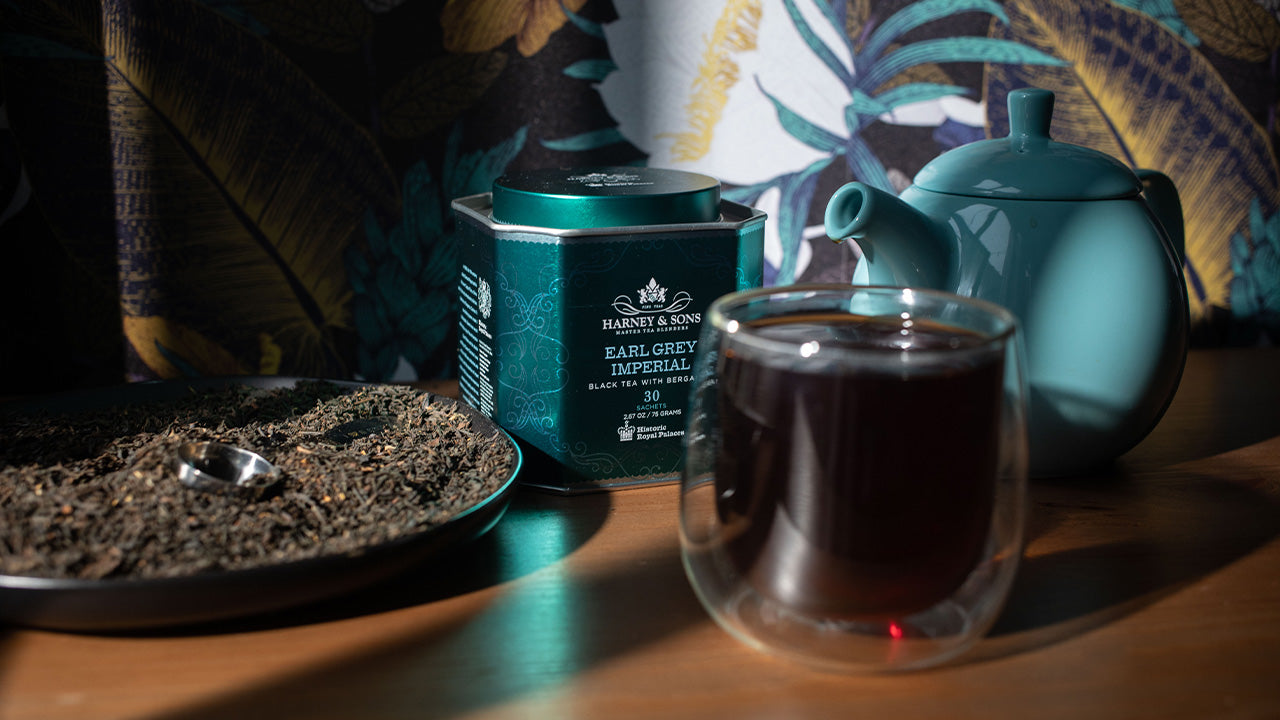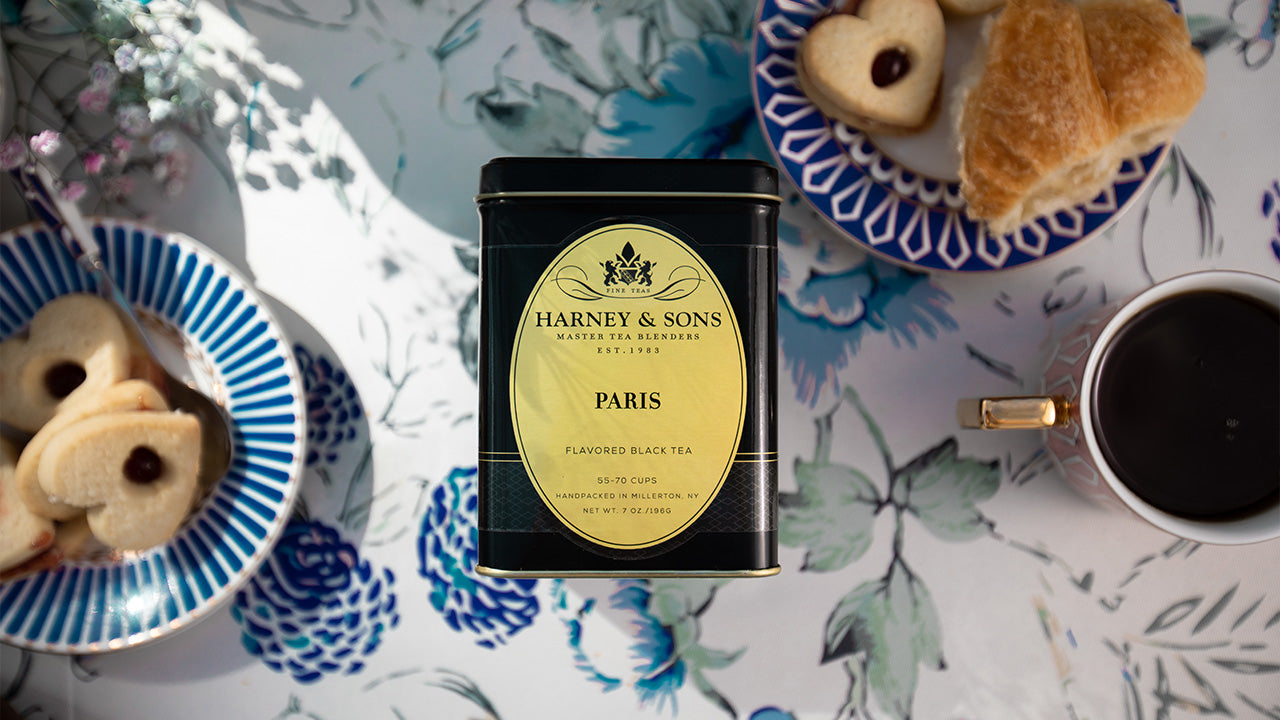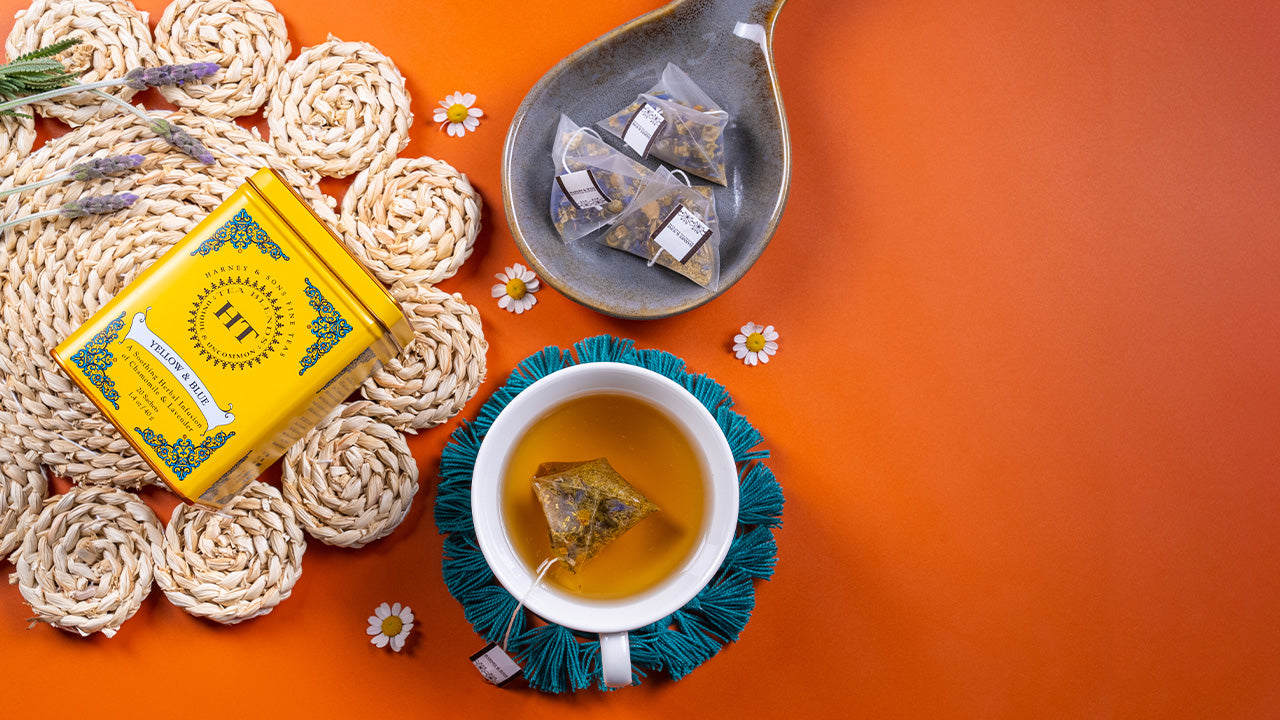If you were doing one of those tests where you have to say the first thing that comes to mind when given a word prompt, if someone said “type of tea,” chances are most people would say “black.” It’s the type of tea most of us were first exposed to if we live outside China or Japan. Before we dive into types of black teas, however, let’s talk about how they’re made.
How Black Teas Are Made
Even if you are a green tea fan, did you know that black and green teas – indeed, virtually all types of teas except herbal – come from the same plant? The Camellia sinensis plant is where all types of teas originate. It’s what happens after the plants are harvested that turns them into the types of tea they are.
So what makes a black tea a black tea, you ask. First, black teas range from mellow teas from China to full-bodied teas from Assam, India. In my dad’s book, The Harney & Sons Guide to Tea, he discusses two categories of black tea: Chinese Black Teas and British Legacy Teas, Mike Harney’s term for those black teas originating from Britain’s tea plantations in India and Sri Lanka. British Legacy Teas were originally developed with an assertive, unsubtle flavor and brisk, tannic body which is why milk and sugar were often added. Many of today’s black teas have evolved to become considerably more sophisticated.

Premium black teas are withered, rolled, oxidized and fired in an oven, creating a warm and toasty flavor. They are oxidized very, very slowly, creating chemical compounds that result in a mild, soft brew. After harvesting the tea leaves, black tea makers do not fix their teas to preserve the green chlorophyll as green tea makers do. Instead, they allow the leaves to darken. The same reaction causes avocados and bananas to brown when their flesh is cut open and exposed to air. During oxidation in tea, an enzyme in the leaves reacts with oxygen to create new brown-colored compounds called “flavonoids.”
The level of flavonoids not only determines the tea’s color, but they also influence its flavors and body. As oxidation begins, the first flavonoid to emerge is called “theaflavin,” which makes the tea golden but also quite brisk and puckery. If oxidation continues, milder flavonoids called “thearubigins” emerge and give the tea a rounded, gentler body and a darker brown color. The slower the oxidation, the more thearubigins, the mellower the tea. Chinese black teas consist mostly of thearubigins, since Chinese tea makers slow down oxidation as much as possible.

Types of Black Teas
The type of production method used is one way to categorize types of black teas. While the highest grade of black teas is processed using what is called the “orthodox” method of oxidizing the whole tea leaf, another method used is CTC, which stands for crush-tear-curl (or sometimes called cut-tear-curl). The CTC process is far less time-consuming than the orthodox method, which means the tea is less expensive (and generally not considered premium). CTC teas are very popular in India, primarily due to cost, and are widely used for chai tea. To learn more about this method of production, see our CTC blog.
Beyond production, black tea types are primarily determined by the location of their origins but also sometimes by flavor. We’ve categorized the black teas we carry as follows: Assam, Darjeeling and Ceylon (British Legacy Teas); Chinese black teas; black tea blends; flavored black teas; decaf black teas; and black teas from other regions. Let’s take a look at a few in each category.
Assam is India’s largest producer of tea, and the broad floodplains make home for some of the most fertile tea estates in the world. Assams are among the most assertive and brisk of the black teas, making them perfect for adding milk and sweeteners.
- CTC Assam. A classic Indian tea, our CTC Assam has a striking amber color, rich flavor and a full body. We use it to create several of our blends, including this next wonderful tea.
- Chai. We start our Chai with the CTC Assam and add in warm spices for a sweet and spicy chai experience.
- Mokalbari Golden Assam. A rare treat from Assam, comprised of nearly 100% golden tips. Natural sweetness in tea comes from tips. The best Assam black teas have some golden tips, so having one that is nearly all golden tips is truly a special tea.

The northeastern region of Darjeeling on the border of Nepal and Bhutan is famous for three seasons of tea: the spring’s First Flush, the early summer’s Second Flush and the late summer and fall’s Autumnal teas. Though they grow more subdued the farther they get from spring, all three seasonal teas have a charming rounded quality, a depth and a gentleness to rival Chinese black teas.
- Darjeeling. Our Darjeeling tea is a blend of First Flush and Autumnal teas from the best gardens. It yields a light color in the cup and a fragrant nose. This blend allows us to create a quality tea at an affordable price.
- Marybong 1st Flush. Like many first flush Darjeelings, Marybong is a brisk cup of tea with an ochre liquor characterized by tropical, citrus flavors and aromas.
- Puttabong 2nd Flush. Second flush Darjeelings are always welcome, especially if they are the elusive “muscatel.” We love fruity flavors that develop when tea plants are attached by leafhoppers. Once attacked, the tea plant reacts by creating a special chemical defense that creates these flavors. This defense is reminiscent of muscatel grapes, thus the name.
Ceylon teas are grown in Sri Lanka. Its unique topography and climate allow for three types of tea, determined not by season but by altitude: low-grown, medium-grown and high-grown, each with its own unusual flavor profile. Ceylon was a British colony until it won independence in 1948, so while the country is now called Sri Lanka, the tea makers there have kept the name Ceylon for their teas. Ceylon teas can brew up light and bright like Lover’s Leap or substantial like Kenilworth Garden. They make perfect afternoon teas and can handle milk and sugar.
- Lover’s Leap. Lover’s Leap is made at one of the prettiest gardens in the world, in the old tea town of Nuwara Eliya. From high in Central Sri Lanka, the teas are light, with hints of lemon.
- Kenilworth Garden. Kenilworth is a wonderful Ceylon black tea, featuring large leaves and full oxidation. The especially smooth liquor has made this a consistent favorite with our Ceylon drinkers.
- Orange Pekoe. Orange Pekoe is a classic, satisfying blend of strong Assam and smooth liquoring Ceylon. A traditional staple in many households, our founder and my grandfather John Harney always drank this tea whenever he needed a mellow, comforting cup.

Tea started in China, thus China has a large variety of black teas. Chinese black teas have all the mellow, sweetened effects of milk and sugar without requiring either. From the honey twinge of Golden Monkey and the Panyang teas to the chocolate of Keemuns and the smokiness of Lapsang Souchong, these teas have a range and character all their own.
- English Breakfast. English Breakfast was never designed or formulated; instead, teas were chosen that were plentiful and not too expensive and that would taste good with milk and sugar. So in the early 1800s, that tea would have been a black tea from China just like this blend: 100% China black Keemun.
- Golden Monkey. Golden Monkey tea comes from the north in China’s Fujian province. It features large black tea leaves interspersed with golden tips. It produces a lightly sweet and “round” cup of tea with a nice level of complexity and hints of apricot, nuts and rose. Also, “monkey” in a tea name is meant to suggest a high-quality tea and has nothing to do with simians!
- Lapsang Souchong. An ancient and much-loved tea, Lapsang Souchong’s large leaves are dried over smoky pine fires, allowing the tea to develop a distinctive smoky flavor.
We have been master tea blenders for 40 years. It’s our pleasure to bring you some of the world’s finest teas in original, delicious blends. Here is just a sampling of our black tea blends.
- Brigitte’s Blend.This black tea blend, named after my mother, Brigitte Harney, is an elegant mixture of silvery Ceylon and golden Assam. Like Brigitte, this signature Harney & Sons blend is perfect in many situations.
- Queen Catherine. We created Queen Catherine with three Chinese black teas (Keemun, Panyang and Yunnan) in honor of Queen Catherine of Braganza, who introduced her love of tea to the British. It’s an interesting blend of muted cocoa and spice.
- All India. All India blend features teas from the three best regions: Assam, Darjeeling and Nilgiri. Each tea brings its own special strengths of body, briskness and aroma.

Our flavored teas are some of the most popular teas we carry, loved for the way our smooth flavors meld with the background taste of tea.
- Hot Cinnamon Spice. Consistently our #1 best-selling tea made with three types of cinnamon, orange peel and cloves. It’s a spicy and sweet tea that people go on and on about. And no, we don’t add any sugar, cross our hearts!
- Earl Grey Supreme. Another extremely popular blend, we’ve taken the classic Earl Grey black tea with bergamot but used a higher grade of teas along with silver tips that take it to the next level.
- Paris. Paris, along with Hot Cinnamon Spice and Earl Grey Supreme, is consistently one of our top five best-selling teas. People rave about Paris, which is basically an Earl Grey base to which we’ve added vanilla, black currant and caramel flavors.
We all need a caffeine break from time to time, some of us more than others. So we took some of our most popular black teas, stripped out the caffeine but left in all the flavor.
- Decaf Vanilla Comoro. Like having dessert in a cup, Vanilla Comoro, our crowd-pleasing decaf version of Vanilla Black, is perfect for late afternoon or an after-dinner treat without the calories and caffeine.
- Decaf Chocolate Tea. This decaf version of our Chocolate tea has the soothing and satisfying flavors of natural chocolate without the caffeine. Indulge away!
- Birthday Tea. We created Decaf Birthday Tea to honor John Harney on his 80th birthday. Delightfully fruity and aromatic, Birthday Tea combines luscious fruit and berry flavors with flowers and brews a beautiful crimson-colored cup of tea.
Yes, there are black teas from other parts of the world than where Chinese black teas and British Legacy Teas come from. We’ve sourced some wonderful teas from Africa, Indonesia, Southern India and Vietnam.
- Colombian Black Tea. Elvira Cardenas, our tea taster, told us someone in her country made good tea, and Elvira knows tea. The company, called Himalaya, is up in the mountains of Colombia and respects tea traditions. It has wonderful honey flavors.
- Japanese Whisky. Japanese Whisky is a rare tea that comes from Shizuoka Prefecture in Japan. It’s made using the same cultivar as most senchas, Yabukita. During its extensive processing, it is finished with an 8-hour smoking over wood chips made from Japanese whisky barrels.
- Kenya Milima. Kenya Milima is Africa’s most elegant black tea, with golden tips reminiscent of fine Assams. Produced with traditional methods at high altitude, this tea is light in body and tends toward citrus.
We hope you’ve enjoyed your tour of the many types of black teas and are inspired to try something new! Can’t get enough black tea knowledge? No worries – head on over to our Black Tea 101 page for even more info!
















2 comments
Dylan
I really appreciate this topic of the different types of black teas. I grew up on sweetened black tea but I’m seeking better quality options. I’m motivated to purchase Colombian Black Tea now. Thank you.
I really appreciate this topic of the different types of black teas. I grew up on sweetened black tea but I’m seeking better quality options. I’m motivated to purchase Colombian Black Tea now. Thank you.
Diane
Lovely and educational discourse! Sipped a nice ceylon as I read this, now I think I shall do some tea shopping.
Lovely and educational discourse! Sipped a nice ceylon as I read this, now I think I shall do some tea shopping.